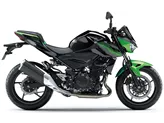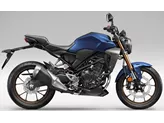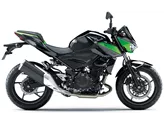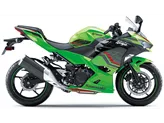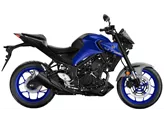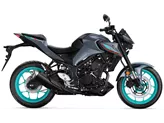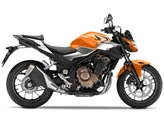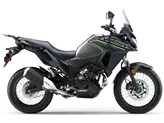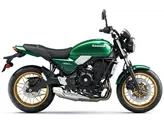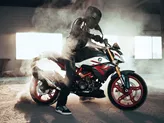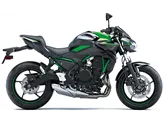Kawasaki Z 300 2016 vs. Kawasaki Z 400 2019

Kawasaki Z 300 2016

Kawasaki Z 400 2019
Overview - Kawasaki Z 300 2016 vs Kawasaki Z 400 2019
The Kawasaki Z 300 2016 and the Kawasaki Z 400 2019 are both naked bikes with similar technical specifications. Both models have an in-line engine with two cylinders and liquid cooling. However, there are several differences between the two models.
In terms of engine power, the Kawasaki Z 400 2019 has a slight advantage with 45 HP compared to the 39 HP of the Kawasaki Z 300 2016. This difference in power translates to a more powerful and responsive ride on the Z 400.
Similarly, the torque of the Z 400 is higher at 38 Nm compared to the 27 Nm of the Z 300. This means that the Z 400 will have better acceleration and pulling power, making it more suitable for riders who enjoy a more spirited riding experience.

Kawasaki Z 300 2016
In terms of chassis, both models feature a steel frame, providing stability and durability. The braking system on both bikes is also similar, with double piston front brakes and petal technology.
When it comes to dimensions and weights, there are a few differences between the two models. The wheelbase of the Z 300 is slightly longer at 1405 mm compared to the 1370 mm of the Z 400. This may result in slightly different handling characteristics, with the Z 300 potentially offering more stability in corners.
Both models have the same seat height of 785 mm, providing a comfortable riding position for most riders. However, the Z 300 is slightly heavier, weighing in at 170 kg with ABS compared to the 167 kg of the Z 400. This difference in weight may be noticeable during maneuvering and low-speed riding.
One significant difference between the two models is the fuel tank capacity. The Z 300 has a larger fuel tank with a capacity of 17 liters, while the Z 400 has a smaller tank with a capacity of 14 liters. This means that the Z 300 has a longer range and may be more suitable for riders who frequently go on long rides without access to fuel stations.

Kawasaki Z 400 2019
In terms of strengths, the Z 300 is praised for its adult look, high-quality finish, high-revving engine, comfortable seating position, stable brakes, easy-to-read cockpit, and low fuel consumption. On the other hand, the Z 400 is commended for its great, controllable power delivery, low weight, good seating position, great sound, and suitability for novice riders.
However, both models have their weaknesses. The Z 300 is criticized for its very unobtrusive sound, favorable chassis components, and the fact that the engine only starts when idling. The Z 400, on the other hand, has non-adjustable clutch and brake levers and a limited adjustable chassis.
In conclusion, the Kawasaki Z 400 2019 offers a slight improvement in engine power and torque compared to the Kawasaki Z 300 2016. It also has a slightly lighter weight and a smaller fuel tank capacity. Both models have their strengths and weaknesses, catering to different types of riders. Ultimately, the choice between the two will depend on individual preferences and riding style.
Technical Specifications Kawasaki Z 300 2016 compared to Kawasaki Z 400 2019
Pros and Cons in comparison
Pros and Cons in comparison
Kawasaki Z 300 2016

The cool design of the Kawasaki Z300, which is extremely similar to that of its big sister Z800, makes it a very grown-up-looking motorbike. The stable braking system and the easy-to-read cockpit with an analogue rev counter and all the necessary features fit in very well with this image. Thanks to the 170 kg ready-to-ride weight, the bike is extremely easy to handle and playful. The engine only reveals its potential in the upper rev range, but revs up willingly and makes you want to ride in a sporty manner. Only the comfort-oriented chassis cannot quite cope with radically sporty demands - but this is quite legitimate and understandable for an entry-level motorbike.
Kawasaki Z 400 2019

The Kawasaki Z400 is definitely a great evolution of its predecessor, the Z300. More power, less weight - all around, simply an even better bike. Above all, the linear power delivery and excellent handling make the Z400 an ideal entry-level bike. The ease of clutch operation and good chassis set-up are also in this vein, which is why the Z400 can be recommended to novice riders without hesitation.
Price Comparison Avarage Market Price Kawasaki Z 300 vs Kawasaki Z 400
There are a few key differences between a Kawasaki Z 300 2016 and a Kawasaki Z 400 2019. It takes less time to sell a Kawasaki Z 300 with 88 days compared to 99 days for a Kawasaki Z 400. Since model year 2015 1000PS.de editors have written 5 reviews for the Kawasaki Z 300 and 8 reviews for the Kawasaki Z 400 since model year 2019. The first review for the Kawasaki Z 300 was published on 04/11/2014 and now has more than 59,800 views. This compares to more than 23,200 views for the first review on Kawasaki Z 400 published on 02/10/2018.


